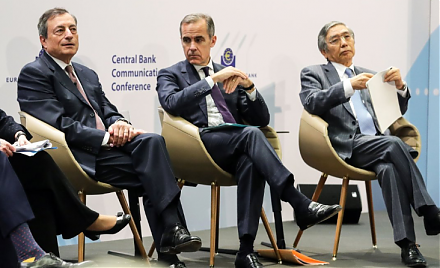

2023-09-14 09:28:00 Thu ET
behavioral finance behavioral economics daniel kahneman richard thaler nicholas barberis utility theory prospect theory epstein-zin recursive utility endowment effect disposition effect equity premium puzzle stock return predictability hyperbolic discounters social norms psychological preferences mental accounts andrei shelifer
Colin Camerer, George Loewenstein, and Matthew Rabin (2003)
Advances in behavioral economics
Colin Camerer, George Loewenstein, and Matthew Rabin delve into the modern advances in the behavioral economic science. These modern advances build upon the seminal work by Nobel Laureates Daniel Kahneman and Richard Thaler, Amos Tversky, Robert Strotz, and many others. Many popular experimental results point out the empirical failures of economic utility theory. Also, several experimental and empirical results support the pervasive endowment effect that economists tend to overlook in most economic utility assessments with no apparent reference point. In addition, hyperbolic discounters choose immediate rewards over distant rewards. This common tendency suggests that many people behaviorally prefer not to delay gratification in the distant future. Further, this common tendency shows that many economic actors implicitly assign different discount rates to future payoffs in most present value terms. In a nutshell, many representative and heterogeneous actors often naturally choose to consider not only economic considerations but also social norms and psychological preferences.
Economic utility theory rests on the independence axiom that most subjects cannot change the frequency of choosing a lottery over another when these lotteries both mix with some other common lottery. Many experiments built by Daniel Kahneman, Amos Tversky, and their co-authors show systematic failures of the independence axiom. Kahneman and Tversky (1979) develop prospect theory to address the core failures of economic utility theory. As these psychologists analyze judgment under uncertainty, it is vital for the researchers to better understand the broader context of subject choices. Prospect theory draws a distinction between gains and losses from some situation-specific reference point. The economic actor evaluates gains and losses differently and then exhibits first-order loss aversion locally around the reference point.
Each economic utility maximizer follows a utility function over consumption lotteries, and then chooses some specific asset portfolio to maximize his or her lifetime utility. For prospect theory, the situation is more complex. When many economic actors make intertemporal choices, these economic actors may not necessarily take into account how their choices affect consumption patterns. In reality, these economic actors view some risky prospects in isolation, or combine the risky prospects with some other risky prospects to evaluate this small subset of lotteries separately. In prospect theory, some reference point distinguishes gains and losses as economic outcomes in support of economic utility evaluation.
Kahneman and Tversky (1979) adapt the new variables of prospect theory to the experiments where the researchers can choose to manipulate the reference point. On one hand, the experimenter can frame some lottery as x with probability p and y with probability 1–p. On the other hand, the experimenter can alternatively frame the same risky prospect as a payment of z and a subsequent lottery of x–z>0 with probability p and the other lottery y–z>0 with probability 1–p. The difference in the 2 alternative lotteries serves as the manipulation of the reference point. Behavioral economists often deal with this ambiguity by treating the reference point as a free variable chosen to match the practical application. In practice, the reference point can be the initial endowment, the value of initial endowment at some specific date, the historical value of an asset endowment, or the present value of all future cash flows from some asset portfolio. Colin Camerer (2003) shows and discusses how behavioral economists apply prospect theory to a wide variety of economic issues such as the equity premium puzzle and monetary policy decisions.
Shlomo Benartzi and Richard Thaler (1997) offer a prospect-theoretic explanation of the equity premium puzzle. In their model, investor utility depends on the annual return on the stock market portfolio. Investors are loss-averse and compute gains and losses with respect to the fair value of the stock market portfolio at the start of each year. This fair value therefore serves as the reference point for annual return assessment. If investors are sufficiently risk-averse around the reference point, the formulation suggests a large equity premium. Both gains and losses recur at short intervals of time (or one year rather than 5 to 10 years). The reference point adjusts incrementally over time. If the reference point remains constant, then the effect of loss aversion fades in due course.
Nicholas Barberis, Ming Huang, and Tano Santos (2001) study asset prices in a prospect-theoretic economy where investors gain utility not only from consumption but also from fluctuations in the value of their financial wealth. These investors are loss averse over these fluctuations, and the degree of loss aversion often depends on their prior investment performance. This mathematical framework helps explain the equity premium puzzle as well as the stock volatility puzzle in terms of the high mean return, excess return volatility, stock return predictability, and the rather low correlation between stock return performance and consumption growth. Prospect theory contributes to the major model design on the basis of experimental evidence in support of how prior gains and losses affect risky intertemporal choices.
Nicholas Barberis, Abhiroop Mukherjee, and Baolian Wang (2016) empirically test the hypothesis that investors mentally represent the stock by the distribution of its past returns. By prospect theory, these investors evaluate this distribution in terms of prior gains and losses from some historical reference point. Each stock whose past return distribution has a high prospect-theoretic value earns a low subsequent return on average. At the same time, each stock whose past return distribution has a low prospect-theoretic value earns a high subsequent return on average. Recent empirical tests lend credence to this prediction in the cross-section of stock returns in the U.S. stock market and a majority of 46 other stock markets worldwide.
Nicholas Barberis, Lawrence Jin, and Baolian Wang (2021) present a new model of asset prices. In this model, investors evaluate risk in accordance with prospect theory. The model includes all elements of prospect theory (i.e. gains and losses around some historical reference point), takes account of prior return experiences, and then provides quantitative predictions about average asset return performance on the basis of empirical estimates of asset return volatility, return skewness, and past capital gain. Recent empirical evidence bolsters the view that this model can help explain more than half of 23 asset return anomalies such as size, value, and momentum etc.
As Terrance Odean (1998) empirically finds, stock market investors are less likely to sell underwater stocks than stocks whose market prices exceed some historical reference point (such as the historical purchase cost and the stock market index). Prospect theory explains this disposition effect because most investors treat each stock investment as a separate decision with respect to the purchase price (or the reference point). Investors behaviorally tolerate more risk when they try to recover losses than when these investors try to increase their gains. As a result, investors may hold onto underwater stocks even though these stock investments would lead to lower average return performance. At the same time, investors may behaviorally choose to pick the low-hanging fruit by selling momentum stocks too soon. In this alternative case, investors tend to realize smaller gains from momentum stocks in light of their longer-run higher average return performance. This disposition effect tends to be quite pervasive in global stock markets.
New York cab drivers often tend to use some daily income target as the reference point, and each of these cab drivers prefers to stop working for the day once he or she achieves the target (Camerer, Babcock, Loewenstein, and Thaler, 2003). This behavior exhibits an extreme form of loss aversion with the target income level as the reference point. As Henry Farber (2005) points out, cab drivers quit early on days when it is easy to make money, and these cab drivers quit late on days when it is hard to make money. Farber (2004) estimates a more general economic utility function with intertemporal substitution and loss aversion around a reference point. For that model, Farber (2004) finds evidence that some reference point may affect the labor supply decision on a given day. However, even for each given cab driver, the reference point (or the daily income target) varies substantially from day to day. Unlike risk aversion or the stochastic discount factor, the reference point need not be consistent across practical applications (or even consistent across time periods for the same application). From a fundamental viewpoint, the reference point tends to capture the subjective unobservable state of the economic decision-maker.
In standard consumer theory, demand serves as a function of wealth and income, but cannot depend on the initial endowment. Richard Thaler (1980) finds the initial endowment effect to describe the common experimental result that subjects often tend to value some good more if it is part of their endowment (than the alternative case where it is not part of their endowment). The endowment effect suggests that economic actors treat additions to their endowments differently from subtractions. Thus, the endowment point serves as a major reference point, and most economic actors experience some kink in their evaluation around the endowment point.
Standard dynamic economic decision theory assumes that intertemporal choices cannot depend on the decision date. Whether most economic actors choose their consumption patterns in the initial period or in the future period tends to cause little effect on the intertemporal choice if the budget constraint remains the same in both cases. Robert Strotz (1955 and 1956) relaxes this assumption to develop a general theoretic model. David Laibson (1997) points out that this new model helps explain experimental evidence in support of immediacy in several economic behaviors. In particular, subjects tend to choose earlier smaller rewards over later larger rewards when the earlier rewards offer immediate consumption. The experimental subjects are hyperbolic discounters who choose to reverse this pattern when the researcher delays both rewards to the more distant future. In essence, hyperbolic discounters choose immediate rewards over distant rewards, so these hyperbolic discounters often prefer not to delay gratification.
David Laibson, Andrea Repetto, and Jeremy Tobacman (2005) estimate the main parameters of Strotz consumer utility functions. This analysis suggests that these consumers would benefit substantially from commitment. In accordance with some comparison of consumer value functions, young and savvy hyperbolic discounters would be willing to pay $2,000 to get rid of their credit cards immediately. However, only a tiny fraction of consumers would cut up their credit cards (Laibson, Repetto, and Tobacman, 2005, p.22). The Strotz consumer utility model can generate this credit card puzzle because the basic ingredients are observable in many economic contexts. Many hyperbolic consumers discount gains more than losses, and these hyperbolic consumers further tend to discount small dollar amounts more than big dollar amounts. These hyperbolic discounters display a great deal of impatience in the experimental context. Nobel Laureate Richard Thaler (1981) finds high annual discount rates over 300% for delaying immediate gratification by one month. More evidence shows annual discount rates of 472% for many consumer market prices and intertemporal trade-offs (Benhabib, Bisin, and Schotter, 2005). Both real and nominal interest rates are often in the low single digits (orders of magnitude off the experimental results). Most rational economic actors typically hold assets such as stocks, bonds, currencies, and residential properties with these low annual returns. For this reason, it is quite difficult for economists to reconcile the behavioral puzzle of hyperbolic discounters with the economic reality of relatively low asset returns.
Standard economic incentive theory assumes that each economic actor makes his or her intertemporal choices on the sole basis of monetary payoffs (i.e. costs and benefits). Werner Guth, Rolf Schmittberger, and Bernd Schwarze (1982) build an experiment to pair subjects in a simple bargaining game. The proposer makes an offer, and the responder either accepts or rejects the offer. A rejection leaves both players with a zero payoff. Responders routinely reject small offers and therefore cannot optimize their selfish monetary payoff. To address this evidence, behavioral economists develop ultimatum bargaining models that allow agent utility to depend on both monetary payoffs to the proposer and the responder. Ernst Fehr and Klaus Schmidt (2003) show that the utility of a player depends on the monetary payoff of all players. All players not only care about the material outcomes of the opponents but also care about whether the opponents are trustworthy actors in the game. As a result, players care about what the other players reveal during the course of the interaction about their character. This interdependence reveals not only economic incentives but also social norms and psychological preferences. In this important way, behavioral economists often present some experimental evidence in violation of standard economic utility theory. These behavioral economists introduce some new variables to parameterize deviations from standard economic models. In new cases, these variables help describe some systematic behavioral biases in several economic games and decisions. The behavioral economic policy prescriptions can contribute to the macro and micro analysis of both costs and benefits versus social norms and preferences.
Larry Epstein and Stanley Zin (1989 and 1991) provide their synthesis of recursive utility theory to build on the Kreps-Porteus model of dynamic choice. Epstein and Zin strive to find a new baseline formulation of macroeconomic causal relations. In this important way, Epstein and Zin formulate more realistic assumptions on most individual behaviors with major departures from economic utility. Economic actors often tend to prefer the early resolution of uncertainty under the Epstein-Zin model. This model maintains the essential structure of recursive utility in macrofinance. In fact, Epstein and Zin deal with the Allais paradox, social anxiety, and many other psychological effects. Central focus remains on the (macro)economic implications of recursive utility for intertemporal trade-offs.
Nobel Laureate Richard Thaler (2003, p.83) points out that sunk costs can still play an important role in many economic decisions. Thaler offers the example of season tickets to a theater. In the standard Thaler model, the initial purchase of the season ticket opens a mental account in the mind of the economic decision-maker with a negative balance. Every time the economic actor fails to attend the theater, he or she experiences a mental loss in proportion to the price of the season ticket. This economic agent wishes to offset this loss with some gain from attending the theater. The economic agent tends to go to the theater if the ticket price is high. Over time the negative effect of the sunk cost wears off. The economic agent interprets this effect as some depreciation of the mental account that records the initial purchase of the ticket. In the second half of the season, the economic actor closes his or her mental account for the season ticket. At this point, the sunk cost no longer plays a role. Recent experimental evidence supports this standard Thaler model of mental accounts for a wide variety of economic decisions.
Behavioral economists often start with a major demonstration of a failure of some common economic assumption. These behavioral economists proceed to provide a psychological explanation for the failure with supportive experimental evidence. This symbiotic relation between both behavioral and standard economic sciences works well as long as behavioral economists make small incremental changes to standard economic assumptions (such as the manipulation of the reference point with respect to gains and losses in prospect theory). Behavioral economists often tend to emphasize the context-dependence of economic decisions. Sometimes, it can be difficult for behavioral economists to extrapolate experimental and empirical results to economic decisions and public policy choices.
Colin Camerer, George Loewenstein, and Matthew Rabin delve into the modern advances in the behavioral economic science. These modern advances build upon the seminal work by Nobel Laureates Daniel Kahneman and Richard Thaler, Amos Tversky, Robert Strotz, and many others. Many popular experimental results point out the empirical failures of economic utility theory. Also, several experimental and empirical results support the pervasive endowment effect that economists tend to overlook in most economic utility assessments with no apparent reference point. In addition, hyperbolic discounters choose immediate rewards over distant rewards. This common tendency suggests that many people behaviorally prefer not to delay gratification in the distant future. Further, this common tendency shows that many economic actors implicitly assign different discount rates to future payoffs in most present value terms. In a nutshell, many representative and heterogeneous actors often naturally choose to consider not only economic considerations but also social norms and psychological preferences.
Economic utility theory rests on the independence axiom that most subjects cannot change the frequency of choosing a lottery over another when these lotteries both mix with some other common lottery. Many experiments built by Daniel Kahneman, Amos Tversky, and their co-authors show systematic failures of the independence axiom. Kahneman and Tversky (1979) develop prospect theory to address the core failures of economic utility theory. As these psychologists analyze judgment under uncertainty, it is vital for the researchers to better understand the broader context of subject choices. Prospect theory draws a distinction between gains and losses from some situation-specific reference point. The economic actor evaluates gains and losses differently and then exhibits first-order loss aversion locally around the reference point.
Each economic utility maximizer follows a utility function over consumption lotteries, and then chooses some specific asset portfolio to maximize his or her lifetime utility. For prospect theory, the situation is more complex. When many economic actors make intertemporal choices, these economic actors may not necessarily take into account how their choices affect consumption patterns. In reality, these economic actors view some risky prospects in isolation, or combine the risky prospects with some other risky prospects to evaluate this small subset of lotteries separately. In prospect theory, some reference point distinguishes gains and losses as economic outcomes in support of economic utility evaluation.
Kahneman and Tversky (1979) adapt the new variables of prospect theory to the experiments where the researchers can choose to manipulate the reference point. On one hand, the experimenter can frame some lottery as x with probability p and y with probability 1–p. On the other hand, the experimenter can alternatively frame the same risky prospect as a payment of z and a subsequent lottery of x–z>0 with probability p and the other lottery y–z>0 with probability 1–p. The difference in the 2 alternative lotteries serves as the manipulation of the reference point. Behavioral economists often deal with this ambiguity by treating the reference point as a free variable chosen to match the practical application. In practice, the reference point can be the initial endowment, the value of initial endowment at some specific date, the historical value of an asset endowment, or the present value of all future cash flows from some asset portfolio. Colin Camerer (2003) shows and discusses how behavioral economists apply prospect theory to a wide variety of economic issues such as the equity premium puzzle and monetary policy decisions.
This analytic essay cannot constitute any form of financial advice, analyst opinion, recommendation, or endorsement. We refrain from engaging in financial advisory services, and we seek to offer our analytic insights into the latest economic trends, stock market topics, investment memes, personal finance tools, and other self-help inspirations. Our proprietary alpha investment algorithmic system helps enrich our AYA fintech network platform as a new social community for stock market investors: https://ayafintech.network.
We share and circulate these informative posts and essays with hyperlinks through our blogs, podcasts, emails, social media channels, and patent specifications. Our goal is to help promote better financial literacy, inclusion, and freedom of the global general public. While we make a conscious effort to optimize our global reach, this optimization retains our current focus on the American stock market.
This free ebook, AYA Analytica, shares new economic insights, investment memes, and stock portfolio strategies through both blog posts and patent specifications on our AYA fintech network platform. AYA fintech network platform is every investor's social toolkit for profitable investment management. We can help empower stock market investors through technology, education, and social integration.
We hope you enjoy the substantive content of this essay! AYA!
Andy Yeh
Chief Financial Architect (CFA) and Financial Risk Manager (FRM)
Brass Ring International Density Enterprise (BRIDE) ©
Do you find it difficult to beat the long-term average 11% stock market return?
It took us 20+ years to design a new profitable algorithmic asset investment model and its attendant proprietary software technology with fintech patent protection in 2+ years. AYA fintech network platform serves as everyone's first aid for his or her personal stock investment portfolio. Our proprietary software technology allows each investor to leverage fintech intelligence and information without exorbitant time commitment. Our dynamic conditional alpha analysis boosts the typical win rate from 70% to 90%+.
Our new alpha model empowers members to be a wiser stock market investor with profitable alpha signals! The proprietary quantitative analysis applies the collective wisdom of Warren Buffett, George Soros, Carl Icahn, Mark Cuban, Tony Robbins, and Nobel Laureates in finance such as Robert Engle, Eugene Fama, Lars Hansen, Robert Lucas, Robert Merton, Edward Prescott, Thomas Sargent, William Sharpe, Robert Shiller, and Christopher Sims.
Follow our Brass Ring Facebook to learn more about the latest financial news and fantastic stock investment ideas: http://www.facebook.com/brassring2013.
Follow AYA Analytica financial health memo (FHM) podcast channel on YouTube: https://www.youtube.com/channel/UCvntmnacYyCmVyQ-c_qjyyQ
Free signup for stock signals: https://ayafintech.network
Mission on profitable signals: https://ayafintech.network/mission.php
Model technical descriptions: https://ayafintech.network/model.php
Blog on stock alpha signals: https://ayafintech.network/blog.php
Freemium base pricing plans: https://ayafintech.network/freemium.php
Signup for periodic updates: https://ayafintech.network/signup.php
Login for freemium benefits: https://ayafintech.network/login.php
If any of our AYA Analytica financial health memos (FHM), blog posts, ebooks, newsletters, and notifications etc, or any other form of online content curation, involves potential copyright concerns, please feel free to contact us at service@ayafintech.network so that we can remove relevant content in response to any such request within a reasonable time frame.
2018-08-19 10:34:00 Sunday ET

The World Economic Forum warns that artificial intelligence may destabilize the financial system. Artificial intelligence poses at least a trifecta of major
2023-12-10 09:23:00 Sunday ET

U.S. federalism and domestic institutional arrangements A given country is federal when both of its national and sub-national governments exercise separa
2018-05-02 06:32:00 Wednesday ET

What are the primary pros and cons of free trade or fair trade in the current Sino-American quagmire? Free trade means allowing goods and services to move a
2024-10-27 07:56:01 Sunday ET

Stock Synopsis: China Internet tech titans continue to grow amid greater competition. We launch our unique coverage of top 25 China Internet stocks. In t
2018-11-15 12:35:00 Thursday ET

Warren Buffett approves Berkshire Hathaway to implement new meaningful stock repurchases. Buffett sends a positive signal to the stock market with the Berks
2019-07-17 12:37:00 Wednesday ET

Gold prices surge above $1400 per ounce amid global trade tension and economic policy uncertainty. Both European Central Bank and Bank of Japan may consider